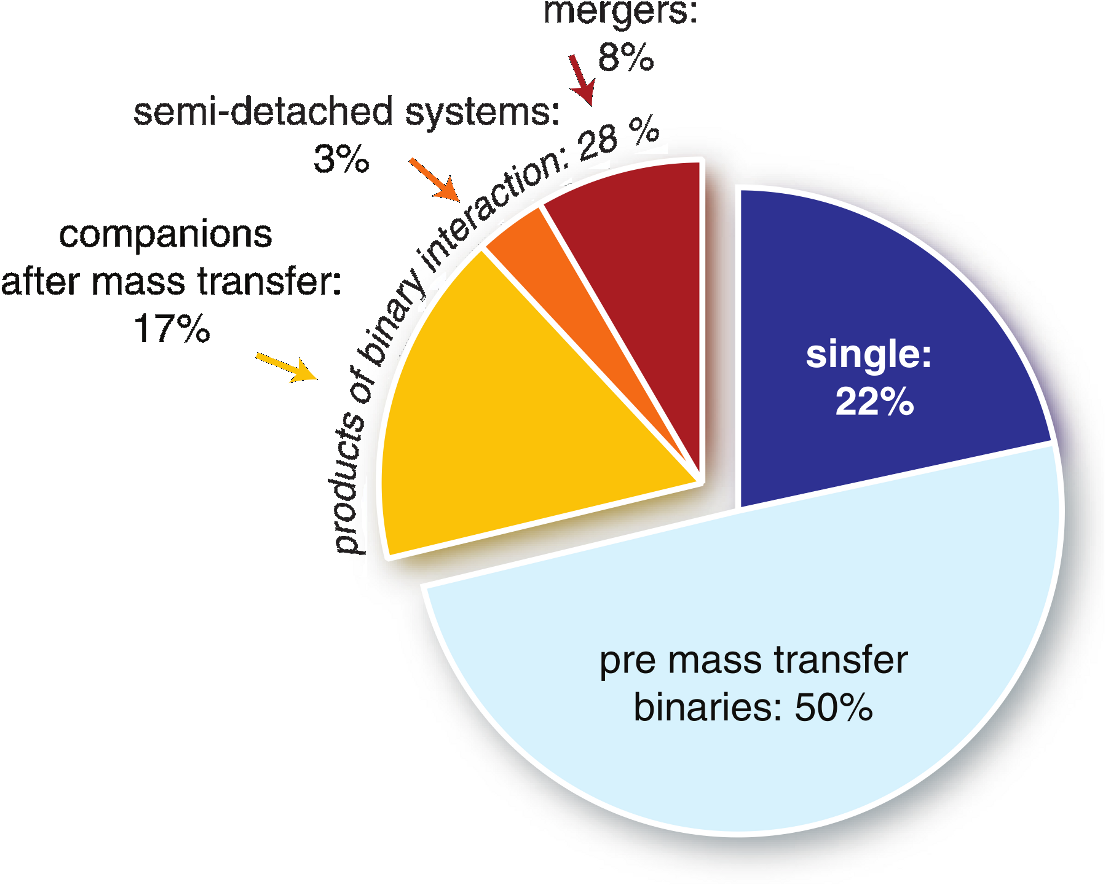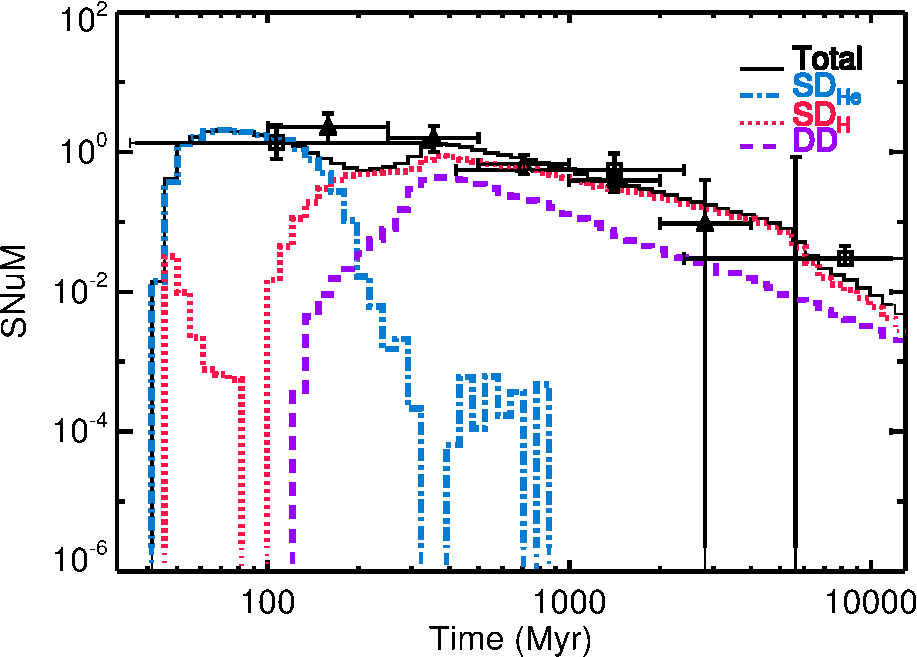|
|
2018 2017 2016 2015 2014 2013 2012 2011 2010 2009 2008 2007 2006 2005 2004 2003 PhD
| BONNSAI: a Bayesian tool for comparing stars with stellar evolution models |
| F.R.N.Schneider, N.Langer, A. de Koter, I. Brott, R.G. Izzard, H.H.B.Lau |

Example posterior probability map generated by BONNSAI.
|
|
Powerful telescopes equipped with multi-fibre or integral field spectrographs combined with detailed models of stellar atmospheres and automated fitting techniques allow for the analysis of large number of stars. These datasets contain a wealth of information that require new analysis techniques to bridge the gap between observations and stellar evolution models. To that end, we develop BONNSAI (BONN Stellar Astrophysics Interface), a Bayesian statistical method, that is capable of comparing all available observables simultaneously to stellar models while taking observed uncertainties and prior knowledge such as initial mass functions and distributions of stellar rotational velocities into account. BONNSAI can be used to (1) determine probability distributions of fundamental stellar parameters such as initial masses and stellar ages from complex datasets, (2) predict stellar parameters that were not yet observationally determined and (3) test stellar models to further advance our understanding of stellar evolution. An important aspect of BONNSAI is that it singles out stars that cannot be reproduced by stellar models through χ2 hypothesis tests and posterior predictive checks. BONNSAI can be used with any set of stellar models and currently supports massive main-sequence single star models of Milky Way and Large and Small Magellanic Cloud composition. We apply our new method to mock stars to demonstrate its functionality and capabilities. In a first application, we use BONNSAI to test the stellar models of Brott et al. (2011a) by comparing the stellar ages inferred for the primary and secondary stars of eclipsing Milky Way binaries. Ages are determined from dynamical masses and radii that are known to better than 3%. We find that the stellar models reproduce the Milky Way binaries well. BONNSAI is available through a web-interface at http://www.astro.uni-bonn.de/stars/bonnsai.
|
| The Ages of Young Star Clusters and the Upper Mass Limit of Stars: Analysing Age-dependent Stellar Mass Functions. |
| F.R.N. Schneider, R.G. Izzard, S.E. de Mink, N. Langer, A. Stolte, A. de Koter, V.V. Gvaramadze, B. Hussmann, A. Liermann, H. Sana. |
| Massive stars rapidly change their masses through strong stellar winds and mass transfer in binary systems. The latter aspect is important for populations of massive stars as more than 70% of all O-stars are expected to interact with a binary companion during their lifetime. We show that such mass changes leave characteristic signatures in stellar mass functions of young star clusters which can be used to infer their ages and to identify products of binary evolution. We model the observed present day mass functions of the young Galactic Arches and Quintuplet star clusters using our rapid binary evolution code. We find that shaping of the mass function by stellar wind mass loss allows us to determine the cluster ages to 3.5 ± 0.7 Myr and 4.8 ± 1.1 Myr, respectively. Exploiting the effects of binary mass exchange on the cluster mass function, we find that the most massive stars in both clusters are rejuvenated products of binary mass transfer, i.e. the massive counterpart of classical blue straggler stars. This resolves the problem of an apparent age spread among the most luminous stars exceeding the expected duration of star formation in these clusters. We perform Monte Carlo simulations to probe stochastic sampling, which support the idea of the most massive stars being rejuvenated binary products. We find that the most massive star is expected to be a binary product after 1.0 ± 0.7Myr in Arches and after 1.7 ± 1.0Myr in Quintuplet. Today, the most massive 9 ± 3 stars in Arches and 8 ± 3 in Quintuplet are expected to be such objects. Our findings have strong implications for the stellar upper mass limit and solve the discrepancy between the claimed 150M⨀ limit and observations of fours stars with initial masses of 165-320M⨀ in R136 and of SN 2007bi, which is thought to be a pair-instability supernova from an initial 250M⨀ star. Using the stellar population of R136, we revise the upper mass limit to values in the range 200-500M⨀.
|

Mass functions of stellar clusters including binary stars.
|
|
| The Incidence of Stellar Mergers and Mass Gainers among Massive Stars |
| S.E. de Mink, H.Sana, N.Langer, R.G.Izzard, F.R.N.Schneider |

The number of single, binary and merged stars predicted to be found in massive O-type populations.
|
|
Because the majority of massive stars are born as members of close binary systems, populations of massive main-sequence stars contain stellar mergers and products of binary mass transfer. We simulate populations of massive stars accounting for all major binary evolution effects based on the most recent binary parameter statistics and extensively evaluate the effect of model uncertainties. Assuming constant star formation, we find that 8+9-4% of a sample of early-type stars are the products of a merger resulting from a close binary system. In total we find that 30+10-15% of massive main-sequence stars are the products of binary interaction. We show that the commonly adopted approach to minimize the effects of binaries on an observed sample by excluding systems detected as binaries through radial velocity campaigns can be counterproductive. Systems with significant radial velocity variations are mostly pre-interaction systems. Excluding them substantially enhances the relative incidence of mergers and binary products in the non-radial velocity variable sample. This poses a challenge for testing single stellar evolutionary models. It also raises the question of whether certain peculiar classes of stars, such as magnetic O stars, are the result of binary interaction and it emphasizes the need to further study the effect of binarity on the diagnostics that are used to derive the fundamental properties (star-formation history, initial mass function, mass-to-light ratio) of stellar populations nearby and at high redshift.
|
| Theoretical uncertainties of the type Ia supernova rate |
| J.S.W.Claeys, O.R.Pols, R.G.Izzard, J.Vink and F.Verbunt |
| It is thought that type Ia supernovae (SNe Ia) are explosions of carbon-oxygen white dwarfs (CO WDs). Two main evolutionary channels are proposed for the WD to reach the critical density required for a thermonuclear explosion: the single degenerate scenario (SD), in which a CO WD accretes from a non-degenerate companion, and the double degenerate scenario (DD), in which two CO WDs merge. However, it remains difficult to reproduce the observed SN Ia rate with these two scenarios. With a binary population synthesis code we study the main evolutionary channels that lead to SNe Ia and we calculate the SN Ia rates and the associated delay time distributions. We find that the DD channel is the dominant formation channel for the longest delay times. The SD channel with helium-rich donors is the dominant channel at the shortest delay times. Our standard model rate is a factor five lower than the observed rate in galaxy clusters. We investigate the influence of ill-constrained aspects of single- and binary-star evolution and uncertain initial binary distributions on the rate of type Ia SNe. These distributions, as well as uncertainties in both helium star evolution and common envelope evolution, have the greatest influence on our calculated rates. Inefficient common envelope evolution increases the relative number of SD explosions such that for αce = 0.2 they dominate the SN Ia rate. Our highest rate is a factor three less than the galaxy-cluster SN Ia rate, but compatible with the rate determined in a field-galaxy dominated sample. If we assume unlimited accretion onto WDs, to maximize the number of SD explosions, our rate is compatible with the observed galaxy-cluster rate.
|

Type Ia supernova delay time distribution for conservative mass transfer onto white dwarfs (Fig.14).
|
|
|
The spectroscopic Hertzsprung-Russell diagram of Galactic massive stars |
| Castro, N.; Fossati, L.; Langer, N.; Simón-Díaz, S.; Schneider, F. R. N.; Izzard, R. G. |
|
|
The distribution of stars in the Hertzsprung-Russell diagram narrates their evolutionary history and directly assesses their properties. Placing stars in this diagram however requires the knowledge of their distances and interstellar extinctions, which are often poorly known for Galactic stars. The spectroscopic Hertzsprung-Russell diagram (sHRD) tells similar evolutionary tales, but is independent of distance and extinction measurements. Based on spectroscopically derived effective temperatures and gravities of almost 600 stars, we derive for the first time the observational distribution of Galactic massive stars in the sHRD. While biases and statistical limitations in the data prevent detailed quantitative conclusions at this time, we see several clear qualitative trends. By comparing the observational sHRD with different state-of-the-art stellar evolutionary predictions, we conclude that convective core overshooting may be mass-dependent and, at high mass (≳15 M⊙), stronger than previously thought. Furthermore, we find evidence for an empirical upper limit in the sHRD for stars with Teff between 10 000 and 32 000 K and, a strikingly large number of objects below this line. This over-density may be due to inflation expanding envelopes in massive main-sequence stars near the Eddington limit.
|
|
|

